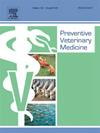Meta-analysis and systematic review of the prevalence and risk factors of animal fascioliasis in Eastern and Southern Africa between 2000 and 2023
IF 2.2
2区 农林科学
Q1 VETERINARY SCIENCES
引用次数: 0
Abstract
Fascioliasis is a zoonotic disease of public health and economic importance. It is caused by trematodes species Fasciola hepatica, and Fasciola gigantica. The parasites infest the liver particularly the bile ducts, and cause harm to the host. The economic loss to both dairy and meat industry is attributed to emaciation, reduction in milk production, death, infertility, and losses to liver condemnation. However, fascioliasis remains poorly studied and limited data is available to guide appropriate interventions especially in low- and middle-income countries. This paper aimed to review the prevalence and risk factors of animal fascioliasis in Eastern and Southern Africa between 2000 and 2023. Globally recognized databases including Science Direct, PubMed and Google scholar were used to search the related studies on fascioliasis conducted between 2000 and 2023 in accordance with PRISMA guidelines. A review of papers was done for risk factors of fascioliasis, and data was extracted. A total of 106 articles met the inclusion criteria, data was extracted, analyzed using meta package in R software (version 4.21), and presented both quantitatively and qualitatively. Forest plots at a 95 % confidence interval were generated to show the prevalence estimate of different subgroups and Cochran’s Q statistic was used to measure the level of heterogeneity between studies. The prevalence estimates for different animal species in Eastern and Southern Africa were 47.5 % (95 % CI: 38.0–57.2 %) in mules, 23.3 % (95 % CI: 17.0–31.1 %) in sheep, 23.4 % (95 % CI: 19.2–28.2 %) in cattle, 23.2 % (95 % CI: 19.3–27.6 %) in donkeys, 12.2 % (95 % CI: 9.9–14.8 %) in horses, and 7.9 % (95 % CI: 5.4–11.5 %) in goats. These findings clearly demonstrate the high prevalence of fascioliasis in animals in Eastern and Southern Africa. We therefore recommend enhanced awareness and promotion of effective prevention measures for the Fasciola infection control to maximize benefits from livestock production.
2000年至2023年非洲东部和南部动物片形吸虫病流行率和危险因素的荟萃分析和系统回顾
片形吸虫病是一种具有公共卫生和经济重要性的人畜共患疾病。它是由吸虫种肝片吸虫和巨型片吸虫引起的。寄生虫寄生于肝脏,特别是胆管,对宿主造成伤害。乳制品和肉类行业的经济损失归因于消瘦、产奶量减少、死亡、不育和肝脏谴责损失。然而,对片形吸虫病的研究仍然很少,可用于指导适当干预措施的数据有限,特别是在低收入和中等收入国家。本文旨在回顾2000年至2023年非洲东部和南部动物片形吸虫病的流行情况和危险因素。采用Science Direct、PubMed和谷歌scholar等全球公认的数据库,按照PRISMA指南检索2000 - 2023年之间关于片形吸虫病的相关研究。我们对片形吸虫病的危险因素进行了文献回顾,并提取了数据。符合纳入标准的文献共106篇,提取数据,使用R软件(4.21版)的meta包进行分析,并进行定量和定性分析。生成95% %置信区间的森林图,以显示不同亚组的患病率估计,并使用Cochran 's Q统计量来衡量研究之间的异质性水平。患病率估计不同的动物物种在非洲东部和南部47.5 %(95 %置信区间:38.0—-57.2 %)在骡子,23.3 %(95 %置信区间:17.0—-31.1 %)在羊,23.4 %(95 %置信区间:19.2—-28.2 %)在牛、23.2 %(95 %置信区间:19.3—-27.6 %)在驴,12.2 %(95 %置信区间:9.9—-14.8 %)在马,和7.9 %(95 %置信区间:5.4—-11.5 %)在山羊。这些发现清楚地表明,东部和南部非洲动物中片吸虫病的流行率很高。因此,我们建议提高对片形吸虫感染控制的认识和推广有效的预防措施,以最大限度地提高畜牧生产的效益。
本文章由计算机程序翻译,如有差异,请以英文原文为准。
求助全文
约1分钟内获得全文
求助全文
来源期刊

Preventive veterinary medicine
农林科学-兽医学
CiteScore
5.60
自引率
7.70%
发文量
184
审稿时长
3 months
期刊介绍:
Preventive Veterinary Medicine is one of the leading international resources for scientific reports on animal health programs and preventive veterinary medicine. The journal follows the guidelines for standardizing and strengthening the reporting of biomedical research which are available from the CONSORT, MOOSE, PRISMA, REFLECT, STARD, and STROBE statements. The journal focuses on:
Epidemiology of health events relevant to domestic and wild animals;
Economic impacts of epidemic and endemic animal and zoonotic diseases;
Latest methods and approaches in veterinary epidemiology;
Disease and infection control or eradication measures;
The "One Health" concept and the relationships between veterinary medicine, human health, animal-production systems, and the environment;
Development of new techniques in surveillance systems and diagnosis;
Evaluation and control of diseases in animal populations.
 求助内容:
求助内容: 应助结果提醒方式:
应助结果提醒方式:


